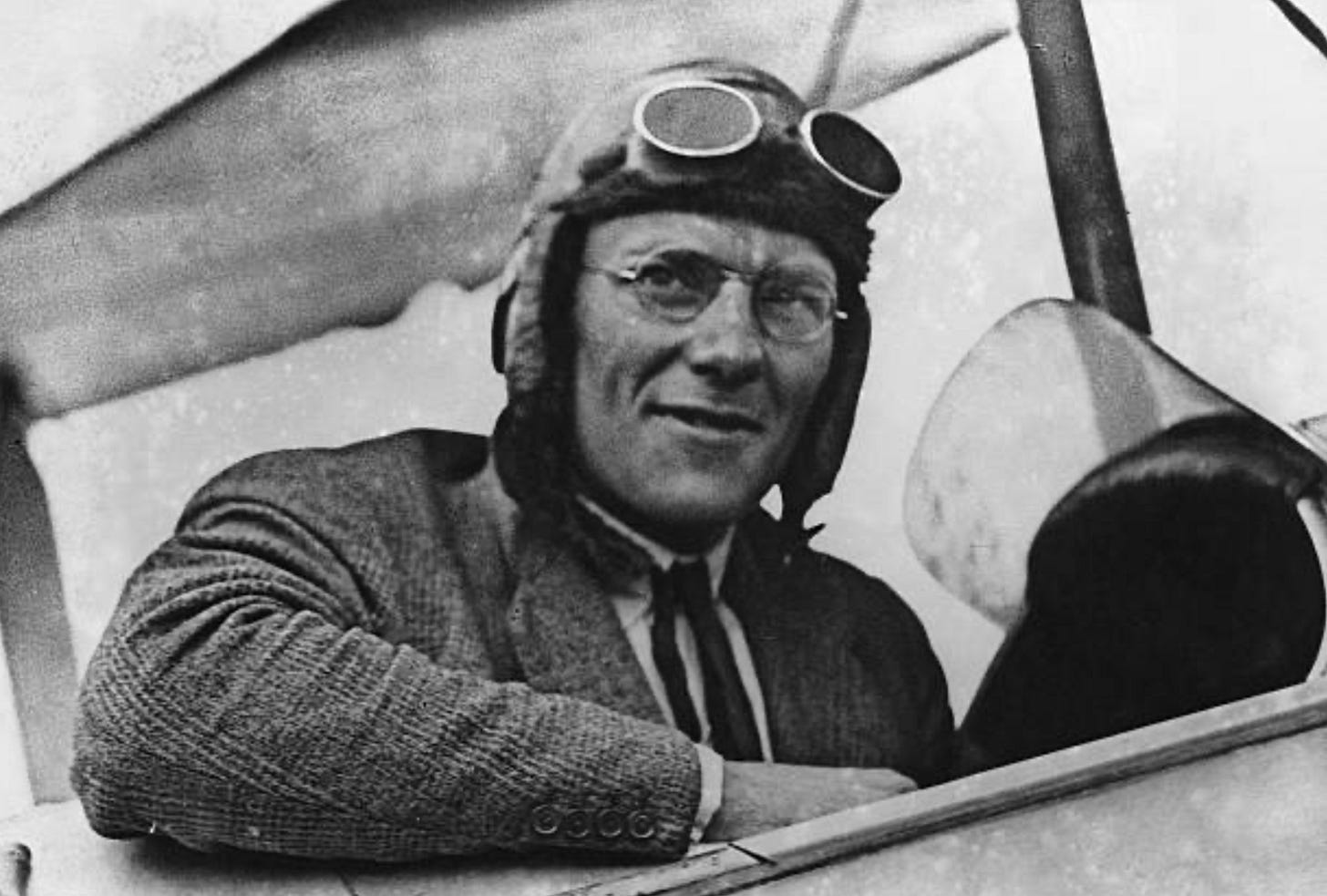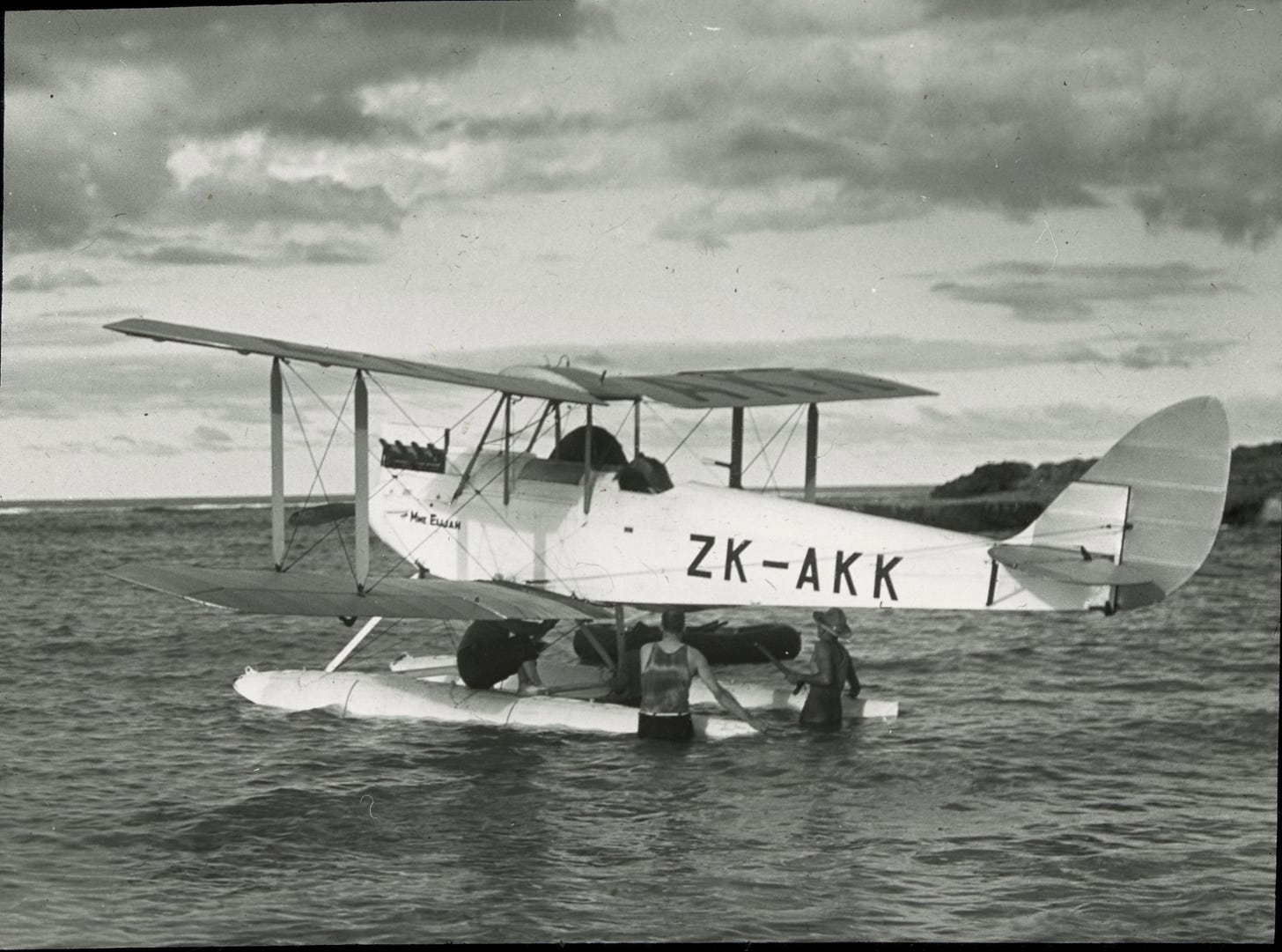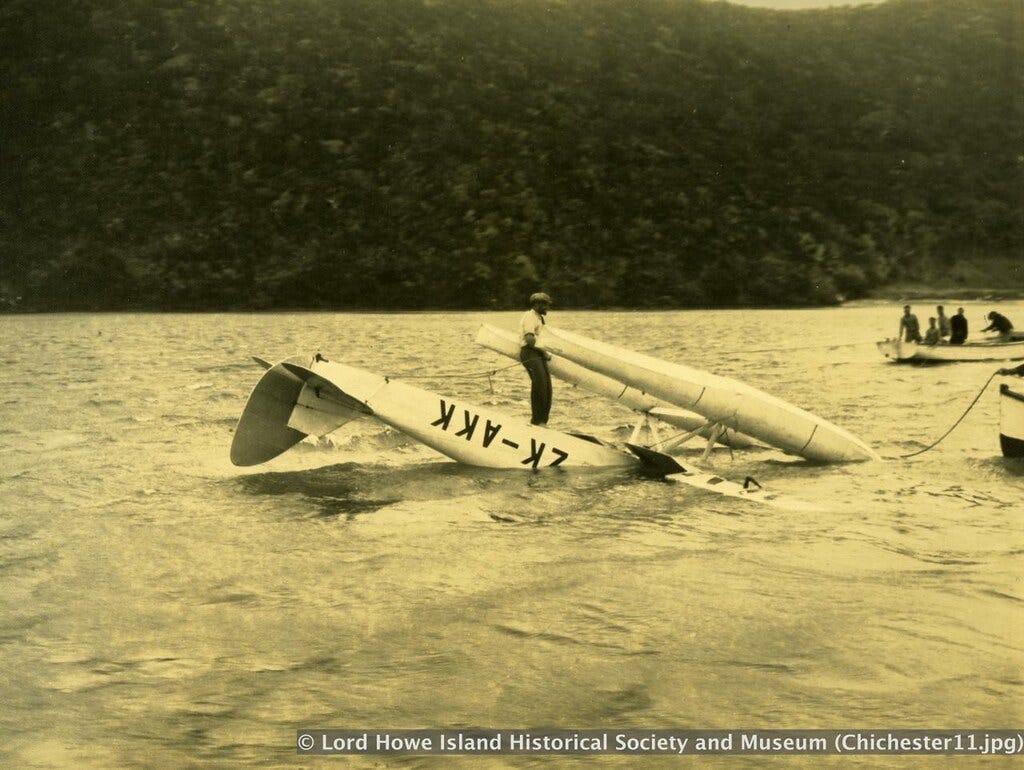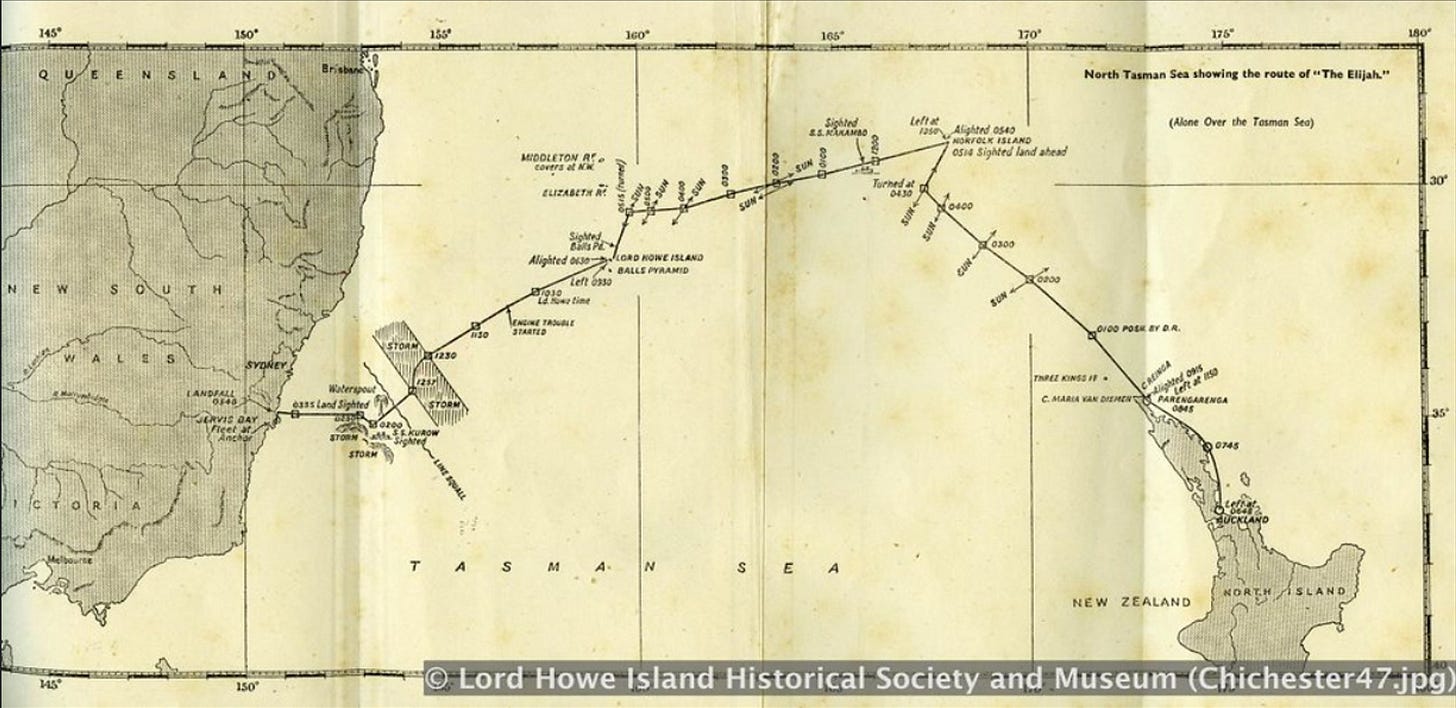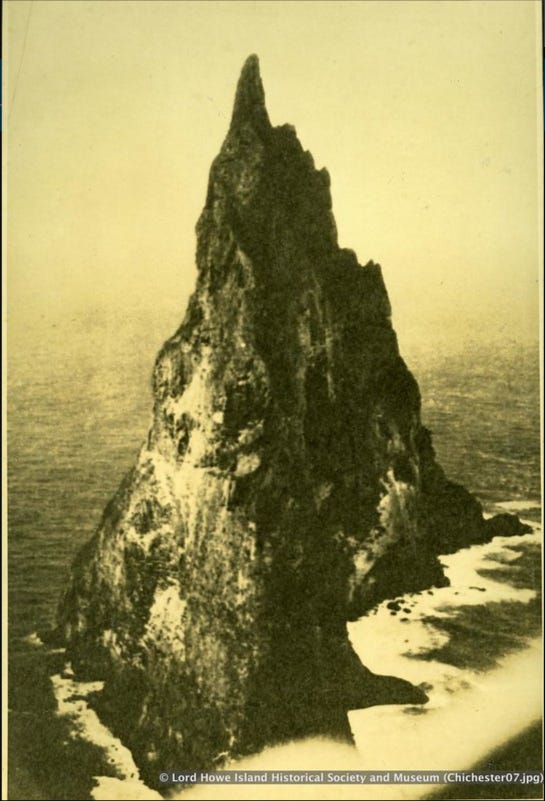Sir Francis Chichester Encountered UFOs Before There Was Such a Thing
Circumnavigator reported incredible experience flying over the Tasman Sea on historic solo flight from New Zealand to Australia in 1931.
Prior to achieving the first solo circumnavigation of the globe by sailboat in 1967, adventurer Sir Francis Chichester was first to fly from New Zealand to Australia alone. He accomplished the journey in 1931, flying an open-cockpit biplane modified to carry a pair of pontoon floats, cruising along at about 85 miles per hour.
Chichester’s historic flight over the Tasman Sea is a tale of daring, ingenuity and determination. The story also contains mystery in the form of an encounter with a then-unknown phenomenon, Unidentified Flying Objects. He detailed the event in his 1933 memoir, “Seaplane Solo.”
The date of Chichester’s encounter was June 10, 1931 — predating by 16 years Kenneth Arnold and his report of nine supersonic objects zipping through the sky over Washington State, like a “saucer would skipping on the water,” June 24, 1947.
Like Chichester earlier, Arnold first noticed the phenomenon by a flash of light — perhaps reflections from shiny surfaces or emitted in some manner by the object itself. Chichester noted the object appeared solid, reflecting sunlight near the front and along the top. It moved suddenly and disappeared before reappearing nearby.
Another possibly significant aspect of Chichester’s encounter is the observation that the object appeared to “get smaller as it approached” — meaning it became more defined and solid in appearance — before shrinking and fading away, leaving only a perfect ring of smoke. While seeming to contradict our current understanding of physics and optical perspective, a number of UFO witnesses have reported similar, even if seemingly absurd and surreal observations in the decades since.
The historic images in this article (except the blimp farther below) are from the Lord Howe Island Historical Society and Museum and the Library of New South Wales.
A Very Light Aircraft
Chichester’s aircraft was a de Havilland DH.60G Gipsy Moth, named “Madame Elijah.” A biplane powered by a 100-horsepower engine, Mme. Elijah had a range of 320 miles, a service ceiling of 14,500 feet, and a climb rate of 500 feet per minute. Its cruising speed was 85 miles per hour, and could open up to 102 mph maximum.
Modifications to Mme. Elijah included two pontoon floats in place of landing gear, and an extra gasoline tank situated in the center of the upper wing. While extending range and enabling water landings, the added drag and weight also diminished the aircraft’s performance and capabilities.
Flying the biplane aircraft also required extended concentration and physical stamina. Difficult under the best of circumstances, imagine flying a propellor driven aircraft with massive pontoons in place of landing gear and then having to land on water — often in difficult conditions, such as cross winds and chop?
Chichester planned three legs for the 1,000-mile flight from New Zealand to Australia. The first stretch was to Howard Island, a small island to the northwest, for rest and refueling, touching down on March 31, 1931. The second headed west/south-west to Lord Howe Island, where he arrived April 1.
Overnight, a burst of wind during a gale overturned the aircraft at its mooring in the lagoon. The mishap caused extensive damage to the aircraft, including engine, instruments, wood frame, struts and supports, fabric-covered wings, and control wires and surfaces. And there were no certified aircraft mechanics among the island’s 150 inhabitants.
At first Chichester thought his adventure at an end and began to consider shipping the aircraft’s salvaged parts to Australia. The residents of Lord Howe Island told him to hold on, they’d help repair Mme. Elijah. And using the tools and materials at hand, combined with the mechanical skills developed living on an isolated island, they did.
Six weeks later, on June 10, 1931, Chichester lifted off. The solo airman waved goodbye to his kind hosts and set course southwest for Sydney, 420 miles of open ocean away.
Flying Saucers in 1931?
From The Aeroplane
November 24, 1950Francis Chichester is known to many as an expert navigator. He is also known as the author of two very good books of flying adventure, “Solo to Sydney” and “Seaplane Solo,” published by Faber and Faber. The last mentioned, which was published in 1933, recounts his trip from New Zealand to Australia across the Tasman Sea in his Moth “Madame Elijah” – converted for the occasion into a floatplane.
During that flight he had some great adventures and suffered severe strain. Some of his observations at the time seemed impossible to explain, except that they were hallucinations induced by fatigue. But some people reading the record to-day may think differently.
However, readers must judge for themselves.
The complete passage witch follows is part of Chichester's account of his flight over the last lap, from Lord Howe Island to Australia. When the passage begins he has been flying for five hours (including a grueling 35-minute stretch through torrential rain storms — FJB).
Typical Royal Navy blimp of the biplane era, from AirShipsOnline. Chichester described the principal object he observed as a “dull grey-white shape of an airship”… “like an oblong pearl.”
(The UFO Report) In His Own Words
“Always, I flew on west; I had always been flying west and I always should be. I sighted land ahead and somewhat to the right. Purple-coloured lowland on sides of a great estuary. The water of the estuary gleamed in the sunlight. Ahead in a roll of white weak clouds a bright light flashed. What was that? Nothing could glitter and flash in a cloud but an aeroplane. I watched the spot intently for a time. More flashes occurred, but I could see no plane.
“Turning to the land, I found that had disappeared. In its place, a long purple-hued cloud lay on the sea at a great distance. Another illusion! It thrust me down into the deepest depths of depression. When I looked back at the flashing light, that too had disappeared. There was not a sign of it. Yes, suddenly it caught my eye 30 degrees to the left front. Then vivid flashes in several places like the dazzle of a heliograph. That, it could not be, it must be a flight of planes. They could hardly be connected with me?
“Then I saw advancing — great heavens! — the dull grey-white shape of an airship. Airship! Impossible! However, there was no doubt about it, and indeed how should I be mistaken in an airship? It nosed towards me like an oblong pearl. Nothing but a cloud or two was visible in the sky for miles. I looked left, sometimes catching a flash or a glint there. Turning again to the airship, I found it had completely vanished.
“I screwed up my eyes, unable to believe them, and twisted the plane this way and that, thinking the airship must be hidden by a blind spot. There was scarcely a wisp of a cloud anywhere near. ‘Heavens,’ I thought, ‘am I seeing things?’ Or was I just being tantalized? Dazzling flashed continued in four or five different places to the left, but still I could pick out no planes.
“Then out of some clouds to my right front I saw another, or the same, airship advancing. I fixed my gaze on it, determined not to look away for a fraction of a second. I'd see what happened to this one if I had to chase it.
“It drew steadily closer until perhaps a mile away when, right under my gaze as it were, it suddenly vanished. I was astonished.
“But it reappeared close to where it had vanished. I watched it angrily with fixed intentness. It drew closer. I could see the dull gleam of light on nose and back. It came on, but instead of increasing in size, it diminished as it approached! When quite near, it suddenly became its own ghost. For one second I could see clear through it and the next, so quickly as a flame can vanish, it had vanished. A diminutive cloud formed perfectly to the shape of an airship and then dissolving. I turned to the flashes; those too had now vanished. I felt stranded in solitude; it was intolerable.”
Source: Digital Collection University of Wyoming (PDF)
https://digitalcollections.uwyo.edu/ahcpublic/UFO/1930s_ah12722.pdf
Having flown for six and-a-half hours, enduring engine trouble for three, and fighting through drenching storms for a terror-filled 35 minutes, Chichester looked to avoid more of the same. Chichester piloted Mme. Elijah on a northwesterly course, before paralleling the coast of New South Wales.
Despite feeling alone and depressed, the aviator kept his wits and carried on for three hours more. Chichester soon spotted land, bringing the seaplane down about 110 miles south of Sydney in Jervis Bay, anchorage of the Royal Australian Navy. Flyer and aircraft were hoisted aboard the aircraft carrier HMAS Albatross and greeted as an “honoured guest” of the RAN, reported author Terry Gwynn-Jones in “Hero of the Tasman.”
Decades later, Sir Francis related his sighting for a news program. Here’s an excerpt:
Ball’s Pyramid, rising from the sea 1,877 feet and only 984 feet across at its widest, is the tallest volcanic sea stack in the world. Located about 12 miles southeast of Lord Howe Island, the aerial photograph was taken on his historic flight by Francis Chichester.



